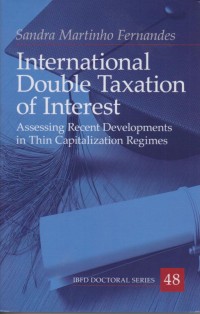
Book
International Double Taxation of Interest
The problem dealt with in this book stems from the rule that interest is deductible (and dividends are not) in calculating taxable income, unless the interest is caught by thin capitalization or anti-abuse rules. Recently, new analysis has shown that multinational groups can plan their worldwide leverage to minimize their overall tax liability, highlighting the risk of base erosion. This has led some countries and international institutions to introduce or recommend the introduction of new, stricter thin capitalization rules, commonly referred to in this book as “Comprehensive Interest Barriers”.
This book, after examining the evolution of the tax treatment of interest and thin capitalization rules, carries out a comparative study of some of the domestic regimes that have adopted this new trend of rules, as well as of the OECD recommended approach under BEPS Action 4 and the interest limitation rule adopted under the Anti-Tax Avoidance Directive. On the basis of the examination of these Comprehensive Interest Barriers, this book concludes that these new rules are not in line with basic international tax principles, namely the net income and ability-to-pay principles, the benefit principle and the arm’s length principle. In addition, these new rules create economic double taxation of interest and realign the taxing rights regarding the taxation of cross-border interest from the country of residence of the creditor to the source country.
On the basis of these conclusions, this book investigates how to implement a single international standard regarding the adequate (i.e. arm’s length) capital structure of an entity by proposing the harmonization of the different capitalization requirements applicable to permanent establishments and subsidiaries (the New Capitalization Standard). By implementing the proposed New Capitalization Standard, an international consensus regarding the amount of capital that should generally be attributed to an entity, as well as the manner in which the said total amount of capital should be split between debt and equity capital, would be crafted, and therefore, a solution to the problem of economic double taxation would also be indirectly achieved. This book also addresses the issue of economic double taxation related to any adjustments to the capital structure.
Detail Information
| Call Number |
16 INT san
|
|---|---|
| Publisher | IBFD : The Netherlands., 2019 |
| Collation |
xix, 437 p, 23.7 cm
|
| Language |
English
|
| Classification |
16 INT san
|
| ISBN/ISSN |
978-90-8722-546-9
|
| Edition |
-
|
| Subject(s) |






